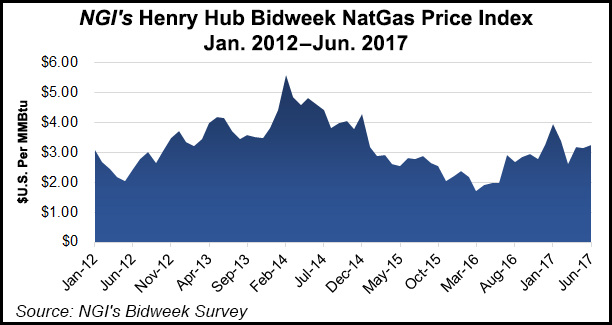Markets | NGI All News Access | NGI The Weekly Gas Market Report
NatGas Prices Stagnant At Least into 2018, With Oil Prices Weak Through 2019, Says BMO
U.S. natural gas supply growth should exceed demand in 2018 and 2019, keeping Henry Hub prices rangebound in 2018 and potentially weak in 2019, BMO Capital Markets analysts said Monday.

U.S. gas prices generally have traded in a $2.50-4.00/Mcf band over the past five years, with exceptions mostly driven by the weather, analysts said. Meanwhile, Canada AECO prices in general have traded even lower, around $1.50-3.50, in part because of of intra-Alberta infrastructure constraints.
“We believe that natural gas prices will remain in these established trading ranges into 2018,” said the BMO team. “We believe that Henry Hub prices could trade lower in 2019 as U.S. production grows faster than demand and see the possibility for weaker AECO prices in mid-2017 with seasonal maintenance and through 2018 as the aggregate growth plans of Canadian producers exceeds available infrastructure capacity.”
U.S. gas production declined 1.8 Bcf/d year/year in 2016, attributed in part to less associated gas from oil drilling activity, as well as infrastructure constraints that led to a pause in Marcellus/Utica shale drilling.
As U.S. shale oil drilling expands this year, associated gas output should expand as well, particularly from the most active region, the Permian Basin.
“We expect Permian natural gas production to grow from 6.7 Bcf/d in 2016 to 7.7 Bcf/d in 2017, and 10.6 Bcf/d in 2018 based on the current rig count,” analysts said.
In addition, gas infrastructure bottlenecks are poised to ease in the Northeast, potentially accelerating more drilling activity.
“We expect Marcellus and Utica production to grow from 21.8 Bcf/d in 2016 to 23.7 Bcf/d in 2017, and 26.8 Bcf/d in 2018,” analysts said. “It is worth noting that this growth appears set at the current rig count.”
Working gas in storage this year is tracking around the five-year average, assuming normal weather. BMO’s model indicates total working gas in storage to exit the summer injection season at roughly 3.8 Tcf.
Next year, U.S. gas demand should increase by 2.8 Bcf/d, with 2019 demand rising another 1.8 Bcf/d, again assuming normal weather conditions, according to BMO.
“Based on the current level of rig activity and our aggregate company forecast, we expect the growth in U.S. supply to exceed the growth in demand in 2018 and 2019. This should keep natural gas prices range-bound in 2018 and points to potential weakness in 2019 as available supply would exceed storage capacity.”
The Energy Information Administration expects Henry spot prices to increase from an average of $3.16/MMBtu this year to $3.41/MMBtu in 2018, based on its latest Short-Term Energy Outlook.
Meanwhile, Western Canadian gas prices periodically have decoupled from U.S. prices because of infrastructure and other local conditions, including weather. Plans for substantial maintenance activities this year could impact Western Canadian gas prices, especially at the Station 2 pricing point on the Spectra system, analysts said.
The spread between Henry Hub and AECO is expected to remain above $1/Mcf into 2018 on the combination of maintenance outages and ongoing growth in the Montney Shale “that will test pipeline capacity,” the BMO team said. “We expect the price spread between AECO and Station 2 to increase over the coming months as pipeline maintenance gets underway. We expect spreads to remain relatively wide through 2019.”
Western Canadian gas production is forecast to increase from 16.2 Bcf/d in 2017 to 17.5 Bcf/d in 2018, and 18.5 Bcf/d in 2019 based on BMO’s corporate models.
“Over the same period, we expect intra-Western Canada demand to increase by roughly 200 MMcf/d each year while exports increase by 300 MMcf/d by 2019.” That structural imbalance between supply growth and demand growth likely will put downward pressure on Canada gas prices relative to Henry Hub.
BMO also reduced its outlook for West Texas Intermediate (WTI) crude oil prices to $48.80/bbl from $50.50.
“We expect WTI to trade in a $40-50/bbl range over the third quarter and move back into the $45-55/bbl range in the fourth quarter as inventories finally begin to draw,” analysts said. “We are also lowering our 2018 assumption to $50/bbl from $52.50 and our 2019 estimate to $50/bbl from $57.”
BMO analysts expect oil prices to remain rangebound for longer because of robust growth by countries that are not part of the Organization of the Petroleum Exporting Countries, which has reduced output targets to March 2018.
Based on the reduced price outlooks, BMO has revised company financial estimates and targets.
For the North American large-cap group, BMO’s earnings estimates were reduced by 8% for 2017 and by 19% for 2018. Cash flow estimates were cut by 1% this year and by 5% in 2018.
International integrated earnings estimates have been lowered by 6% for 2017 and by 8% in 2018, with target prices reduced on average by 5%.
For North America’s small-to-medium cap group, earnings estimates have been cut 8% in 2017 and 13% in 2018, with cash flow estimates down by 1% this year and 6% next year.
© 2024 Natural Gas Intelligence. All rights reserved.
ISSN © 1532-1231 | ISSN © 2577-9877 | ISSN © 1532-1266 |
